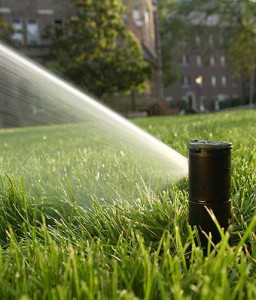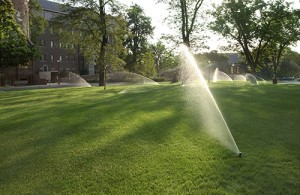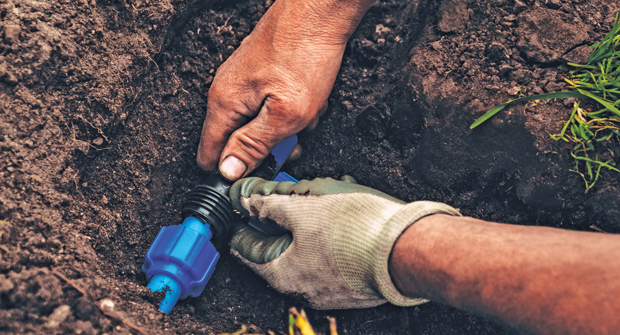
Rotors must deliver on two things, Brent Barkley says: “convenience and efficiency.” Which is why “rotors continue to evolve,” working toward the goal of putting an end to the days when property owners have to choose between saving water and having a well-maintained lawn, says the product manager for rotors and rotary nozzles at the Rain Bird Corp.
Contractors and property owners alike see the benefits of improvements in rotor quality and design. The result is low-maintenance irrigation systems that meet or exceed water regulations throughout the country.
“(The need for) convenience is driven by contractor demand to reduce costs with easier installation, less maintenance and longer durability,” Barkley says. “There’s also a significant increase in customer awareness of water as a natural resource, and that’s playing a role in rotor trends, as well.”
Orion Goe, product manager for The Toro Co., agrees that advancements in rotors continue to make them more efficient and easier for the contractor to install and maintain.
Water shortages and restrictions as a result of them mean the general public finally is paying attention to how it manages water, he says. Goe adds that contractors also are looking for high-quality rotors to improve their clients’ systems for the long term.
“In speaking with our customers and industry professionals, contractors and users are looking for water-efficient rotors that are easily retrofitted into existing systems, are high-quality designs made from high-quality materials and are easy to operate and maintain,” Goe says.
Such improvements in rotor quality and design have allowed some manufacturers to put more emphasis on the longevity of their products.

Barkley says contractors can expect new rotors to include stronger materials and a better seal to help extend their life expectancy; a heavier, thicker case to increase the product’s burst strength; and a second lip on the wiper seal to better prevent leaks—one of the most common points of rotor failure.
“Contractors and homeowners want a product that will work reliably and properly for years without replacement, so the biggest convenience feature may be improved durability,” Barkley says. “This means more reliable operation for the homeowner with less chance of a failure that could lead to wasted water or a dying landscape. For the contractor, it means peace of mind that they won’t have to return to the job site, and they can offer a more robust system warranty to their customers.”
While rotors with increased convenience and efficiency have universal appeal and are being adopted throughout the country, some regions are leading the way for specific advancements.
For example, contractors in Florida and Southern California are the biggest users of non-potable rotors to accommodate reclaimed water systems, Barkley says. Severely affected by the drought, Southern California has some of the most progressive water management districts in the country, Barkley says, and has taken major steps to integrate reclaimed water practices.
Pressure-regulating rotors are another regional trend largely adopted in the Midwest, the Northeast and around the Great Lakes, Barkley adds, because of the regions’ windy environments with high water pressures.
And while non-potable rotors and pressure-regulating rotors are trending only regionally now, Barkley predicts both will pick up steam on a larger scale in the near future. An increased demand for rotors for non-potable water also will reinforce the need for more durable products that can stand up to the wear and tear caused by reclaimed water, he adds.

“There’s no question that the responsible use of water will continue to be a key topic that drives product development, along with more government regulations and increased customer awareness,” Barkley says. “Rotor features that support smart water use will be in high demand as water prices and homeowner awareness increase.”
Goe says the future of rotors also includes technology to help contractors work smarter so they may, in turn, deliver homeowners a more enjoyable, high-quality landscaping.
These advancements include features that offer high distribution uniformity; more intuitive arc and radius adjustments; a wider range of trajectory adjustment at the head; and components and materials that are more tolerant to changing environmental factors such as pesticides, fertilizers and ultraviolet rays.
“Landscaping says a lot about a company and homeowners take pride in the appearance of their landscapes,” Goe says. “Companies and homeowners alike want to be sure their landscaping presents well and is in good order, but they want to do this as efficiently as they can.”
A properly designed irrigation system is the solution, Barkley says, and the rotors and other new products that compose it are what will deliver beautiful landscapes that can be maintained using water in a sustainable, responsible way.
“Societal pressure, increased regulation and higher water costs have made homeowners feel like they must sacrifice the beauty and recreational benefits of their landscapes in order to use less water,” he says. “Continuously improving rotor efficiency means better sustainability for our water resources and the industry as a whole.”
Adds Goe, “Water-efficient rotors that are easy to use are a small piece of the much larger puzzle.”
Schappacher is a freelance writer based in Charlotte, N.C.

